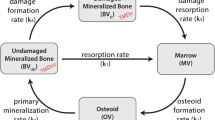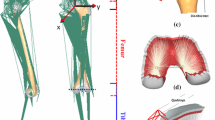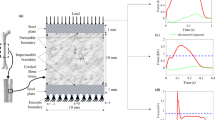Abstract
In Thoroughbred racehorses, fractures of the distal limb are commonly catastrophic. Most of these fractures occur due to the accumulation of fatigue damage from repetitive loading, as evidenced by microdamage at the predilection sites for fracture. Adaptation of the bone in response to training loads is important for fatigue resistance. In order to better understand the mechanism of subchondral bone adaptation to its loading environment, we utilised a square root function defining the relationship between bone volume fraction \((f_{BM} )\) and specific surface \((S_v )\) of the subchondral bone of the lateral condyles of the third metacarpal bone (MCIII) of the racehorse, and using this equation, developed a mathematical model of subchondral bone that adapts to loading conditions observed in vivo. The model is expressed as an ordinary differential equation incorporating a formation rate that is dependent on strain energy density. The loading conditions applied to a selected subchondral region, i.e. volume of interest, were estimated based on joint contact forces sustained by racehorses in training. For each of the initial conditions of \(f_{BM} \) we found no difference between subsequent homoeostatic \(f_{BM} \) at any given loading condition, but the time to reach equilibrium differed by initial \(f_{BM} \) and loading condition. We found that the observed values for \(f_{BM} \) from the mathematical model output were a good approximation to the existing data for racehorses in training or at rest. This model provides the basis for understanding the effect of changes to training strategies that may reduce the risk of racehorse injury.





Similar content being viewed by others
Abbreviations
- \(f_{BM}\) :
-
Bone volume fraction (proportion)
- \(S_{v} \) :
-
Bone specific surface (\(\hbox {mm}^{-1}\))
- \(\alpha \) :
-
Fraction of bone specific surface (proportion)
- E :
-
Bone stiffness (MPa)
- \(\mu \) :
-
Osteocyte mechanosensitivity [\(\hbox {nmol}/(\hbox {MPa}\cdot \,\upmu \hbox {m}^{2})\)]
- \(k_\mathrm{f} \) :
-
Bone formation rate [\(\upmu \hbox {m}^{3}/\hbox {(nmol}\cdot \hbox {day)}\)]
- \(\tau \) :
-
Bone formation rate, dependant on \(\psi _\mathrm{tissue} \) [\(\upmu \hbox {m}^{3}/\hbox {(nmol}\cdot \,\hbox {day)}\)]
- \(k_\mathrm{r} \) :
-
Bone resorption rate [\(\upmu \hbox {m}^{3}/\hbox {(nmol}\cdot \hbox {day)}\)]
- \(A_\mathrm{OCL} \) :
-
Bone resorption rate via osteoclast activity [\(\upmu \hbox {m}^{3}/\hbox {(nmol}\cdot \hbox {day)}\)]
- \(\alpha _\mathrm{f} \) :
-
Fraction of specific surface available for formation (proportion)
- \(\alpha _\mathrm{r} \) :
-
Fraction of specific surface available for resorption (proportion)
- \(\psi _\mathrm{tissue} \) :
-
Strain energy density (MPa)
- \(\delta \) :
-
\(\psi _\mathrm{tissue} \) at half maximal \(\tau \) (MPa)
- \(\gamma \) :
-
Sigmoidicity, curve gradient
- \(\sigma _{zz} \) :
-
Stress-state (applied loading; applied stress) (MPa)
- \(\varepsilon _{zz} \) :
-
Strain-state
- t :
-
Time (days)
- v :
-
Poisson’s ratio (ratio)
References
Andreaus U, Colloca M, Iacoviello D (2012) An optimal control procedure for bone adaptation under mechanical stimulus. Control Eng Pract 20:575–583. https://doi.org/10.1016/j.conengprac.2012.02.002
Andreaus U, Colloca M, Iacoviello D (2013) Modeling of trabecular architecture as result of an optimal control procedure. In: Andreaus U, Iacoviello D (eds) Biomedical imaging and computational modeling in biomechanics. Springer, Berlin, pp 19–37. https://doi.org/10.1007/978-94-007-4270-3_2
Andreaus U, Colloca M, Iacoviello D (2014) Optimal bone density distributions: numerical analysis of the osteocyte spatial influence in bone remodeling. Comput Methods Programs Biomed 113:80–91. https://doi.org/10.1016/j.cmpb.2013.09.002
Andreaus U, Colloca M, Iacoviello D, Pignataro M (2011) Optimal-tuning PID control of adaptive materials for structural efficiency. Struct Multidiscip Optim 43:43–59. https://doi.org/10.1007/s00158-010-0531-9
Barr E, Pinchbeck G, Clegg P, Boyde A, Riggs C (2009) Post mortem evaluation of palmar osteochondral disease (traumatic osteochondrosis) of the metacarpo/metatarsophalangeal joint in Thoroughbred racehorses. Equine Vet J 41:366–371. https://doi.org/10.2746/042516409X368372
Boden LA, Anderson GA, Charles JA, Morgan KL, Morton JM, Parkin TDH, Slocombe RF, Clarke AF (2006) Risk of fatality and causes of death of Thoroughbred horses associated with racing in Victoria, Australia: 1989–2004. Equine Vet J 38:312–318. https://doi.org/10.2746/042516406777749182
Bowman S, Guo X, Cheng D, Keaveny T, Gibson L, Hayes W, McMahon T (1998) Creep contributes to the fatigue behavior of bovine trabecular bone. J Biomech Eng 120:647–654. https://doi.org/10.1115/1.2834757
Boyde A, Firth EC (2005) Musculoskeletal responses of 2-year-old Thoroughbred horses to early training. 8. Quantitative back-scattered electron scanning electron microscopy and confocal fluorescence microscopy of the epiphysis of the third metacarpal bone. NZ Vet J 53:123–132. https://doi.org/10.1080/00480169.2005.36489
Carter DR, Hayes WC (1976) Fatigue life of compact bone: I effects of stress amplitude, temperature and density. J Biomech 9:IN7-34. https://doi.org/10.1016/0021-9290(76)90136-6
Carter DR, Hayes WC (1977) The compressive behavior of bone as a two-phase porous structure. J Bone Joint Surg 59:954–962. https://doi.org/10.2106/00004623-197759070-00021
Colloca M, Blanchard R, Hellmich C, Ito K, van Rietbergen B (2014) A multiscale analytical approach for bone remodeling simulations: linking scales from collagen to trabeculae. Bone 64:303–313. https://doi.org/10.1016/j.bone.2014.03.050
Cook DD, Robertson DJ (2016) The generic modeling fallacy: average biomechanical models often produce non-average results!. J Biomech 496:3609–3615. https://doi.org/10.1016/j.jbiomech.2016.10.004
Davies HMS (1995) The adaptive response of the equine metacarpus to locomotory stress. Doctoral dissertation. University of Melbourne, Australia
Dempster DW, Compston JE, Drezner MK, Glorieux FH, Kanis JA, Malluche H, Meunier PJ, Ott SM, Recker RR, Parfitt AM (2013) Standardized nomenclature, symbols, and units for bone histomorphometry: a 2012 update of the report of the ASBMR Histomorphometry Nomenclature Committee. J Bone Miner Res 28:2–17. https://doi.org/10.1002/jbmr.1805
Edwards BW, Taylor D, Rudolphi TJ, Gillette JC, Derrick TR (2010) Effects of running speed on a probabilistic stress fracture model. Clin Biomech 25:372–377. https://doi.org/10.1016/j.clinbiomech.2010.01.001
Edwards WB, Taylor D, Rudolphi TJ, Gillette JC, Derrick TR (2009) Effects of stride length and running mileage on a probabilistic stress fracture model. Med Sci Sports Exerc 41:2177–2184. https://doi.org/10.1249/MSS.0b013e3181a984c4
Fatihhi SJ, Harun MN, Abdul Kadir MR, Abdullah J, Kamarul T, Öchsner A, Syahrom A (2015) Uniaxial and multiaxial fatigue life prediction of the trabecular bone based on physiological loading: a comparative study. Ann Biomed Eng 43:2487–2502. https://doi.org/10.1007/s10439-015-1305-8
Fatihhi SJ, Rabiatul AAR, Harun MN, Kadir MRA, Kamarul T, Syahrom A (2016) Effect of torsional loading on compressive fatigue behaviour of trabecular bone. J Mech Behav Biomed 54:21–32. https://doi.org/10.1016/j.jmbbm.2015.09.006
Firth E, Rogers C, Doube M, Jopson N (2005) Musculoskeletal responses of 2-year-old Thoroughbred horses to early training. 6. Bone parameters in the third metacarpal and third metatarsal bones. NZ Vet J 53:101–112. https://doi.org/10.1080/00480169.2005.36487
Fyhrie DP, Fazzalari N, Goulet R, Goldstein S (1993) Direct calculation of the surface-to-volume ratio for human cancellous bone. J Biomech 26:955–967. https://doi.org/10.1016/0021-9290(93)90057-l
Fyhrie DP, Kimura JH (1999) Cancellous bone biomechanics. J Biomech 32:1139–1148. https://doi.org/10.1016/S0021-9290(99)00114-1
Gabbett TJ, Hulin BT, Blanch P, Whiteley R (2016) High training workloads alone do not cause sports injuries: how you get there is the real issue. Br J Sports Med 50:444–445. https://doi.org/10.1136/bjsports-2015-095567
Hardin JW, Hilbe JM, Hilbe J (2007) Generalized linear models and extensions. Stata Press, College Station, TX
Harrison SM, Whitton RC, Kawcak CE, Stover SM, Pandy MG (2010) Relationship between muscle forces, joint loading and utilization of elastic strain energy in equine locomotion. J Exp Bio 213:3998–4009. https://doi.org/10.1242/jeb.044545
Harrison SM, Whitton RC, Kawcak CE, Stover SM, Pandy MG (2014) Evaluation of a subject-specific finite-element model of the equine metacarpophalangeal joint under physiological load. J Biomech 47:65–73. https://doi.org/10.1016/j.jbiomech.2013.10.001
Harrison SM, Whitton RC, King M, Haussler KK, Kawcak CE, Stover SM, Pandy MG (2012) Forelimb muscle activity during equine locomotion. J Exp Bio 215:2980–2991. https://doi.org/10.1242/jeb.065441
Hernandez C, Beaupre G, Keller T, Carter D (2001) The influence of bone volume fraction and ash fraction on bone strength and modulus. Bone 29:74–78. https://doi.org/10.1016/s8756-3282(01)00467-7
Hjertén G, Drevemo S (1994) Semi-quantitative analysis of hoof-strike in the horse. J Biomech 27:997–1004. https://doi.org/10.1016/0021-9290(94)90216-X
Holmes J, Mirams M, Mackie E, Whitton R (2014) Thoroughbred horses in race training have lower levels of subchondral bone remodelling in highly loaded regions of the distal metacarpus compared to horses resting from training. Vet J 202:443–447. https://doi.org/10.1016/j.tvjl.2014.09.010
Kawcak CE, McIlwraith CW, Firth EC (2010) Effects of early exercise on metacarpophalangeal joints in horses. Am J Vet Res 71:405–411. https://doi.org/10.2460/ajvr.71.4.405
Lerebours C, Thomas C, Clement J, Buenzli P, Pivonka P (2015) The relationship between porosity and specific surface in human cortical bone is subject specific. Bone 72:109–117. https://doi.org/10.1016/j.bone.2014.11.016
Les CM, Keyak JH, Stover SM, Taylor KT, Kaneps AJ (1994) Estimation of material properties in the equine metacarpus with use of quantitative computed tomography. J Orthop Res 12:822–833. https://doi.org/10.1002/jor.1100120610
Martig S, Chen W, Lee PVS, Whitton RC (2014) Bone fatigue and its implications for injuries in racehorses. Equine Vet J 46:408–415. https://doi.org/10.1111/evj.12241
Martig S, Lee PVS, Anderson GA, Whitton RC (2013) Compressive fatigue life of subchondral bone of the metacarpal condyle in thoroughbred racehorses. Bone 57:392–398. https://doi.org/10.1016/j.bone.2013.09.006
Martin RB (1984) Porosity and specific surface of bone. Crit Rev Biomed Eng 10:179–222
McGuigan MP, Wilson AM (2003) The effect of gait and digital flexor muscle activation on limb compliance in the forelimb of the horse Equus caballus. J Exp Biol 206:1325–1336. https://doi.org/10.1242/jeb.00254
Muir P, Peterson AL, Sample SJ, Scollay MC, Markel MD, Kalscheur VL (2008) Exercise-induced metacarpophalangeal joint adaptation in the Thoroughbred racehorse. J Anat 213:706–717. https://doi.org/10.1111/j.1469-7580.2008.00996.x
Murray R, Vedi S, Birch H, Lakhani K, Goodship A (2001) Subchondral bone thickness, hardness and remodelling are influenced by short-term exercise in a site-specific manner. J Orthop Res 19:1035–1042. https://doi.org/10.1016/s0736-0266(01)00027-4
Nazarian A, Stauber M, Zurakowski D, Snyder BD, Müller R (2006) The interaction of microstructure and volume fraction in predicting failure in cancellous bone. Bone 39:1196–1202. https://doi.org/10.1016/j.bone.2006.06.013
Parfitt AM, Drezner MK, Glorieux FH, Kanis JA, Malluche H, Meunier PJ, Ott SM, Recker RR (1987) Bone histomorphometry: standardization of nomenclature, symbols, and units: report of the ASBMR Histomorphometry Nomenclature Committee. J Bone Miner Res 2:595–610. https://doi.org/10.1002/jbmr.5650020617
Peterson MC, Riggs MM (2010) A physiologically based mathematical model of integrated calcium homeostasis and bone remodeling. Bone 46:49–63. https://doi.org/10.1016/j.bone.2009.08.053
Pinchbeck G, Clegg P, Boyde A, Riggs C (2013) Pathological and clinical features associated with palmar/plantar osteochondral disease of the metacarpo/metatarsophalangeal joint in Thoroughbred racehorses. Equine Vet J 45:587–592. https://doi.org/10.1111/evj.12036
Pivonka P, Buenzli PR, Scheiner S, Hellmich C, Dunstan CR (2013) The influence of bone surface availability in bone remodelling—a mathematical model including coupled geometrical and biomechanical regulations of bone cells. Eng Struct 47:134–147. https://doi.org/10.1016/j.engstruct.2012.09.006
Pothuaud L, Van Rietbergen B, Mosekilde L, Beuf O, Levitz P, Benhamou CL, Majumdar S (2002) Combination of topological parameters and bone volume fraction better predicts the mechanical properties of trabecular bone. J Biomech 35:1091–1099. https://doi.org/10.1016/s0021-9290(02)00060-x
Powell SE (2012) Low-field standing magnetic resonance imaging findings of the metacarpo/metatarsophalangeal joint of racing Thoroughbreds with lameness localised to the region: a retrospective study of 131 horses. Equine Vet J 44:169–177. https://doi.org/10.1111/j.2042-3306.2011.00389.x
Rapillard L, Charlebois M, Zysset PK (2006) Compressive fatigue behavior of human vertebral trabecular bone. J Biomech 39:2133–2139. https://doi.org/10.1016/j.jbiomech.2005.04.033
Riggs C, Whitehouse G, Boyde A (1999a) Pathology of the distal condyles of the third metacarpal and third metatarsal bones of the horse. Equine Vet J 31:140–148. https://doi.org/10.1111/j.2042-3306.1999.tb03807.x
Riggs CM, Whitehouse GH, Boyde A (1999b) Structural variation of the distal condyles of the third metacarpal and third metatarsal bones in the horse. Equine Vet J 31:130–139. https://doi.org/10.1111/j.2042-3306.1999.tb03806.x
Rosanowski S, Chang Y, Stirk A, Verheyen K (2017) Descriptive epidemiology of veterinary events in flat racing Thoroughbreds in Great Britain (2000 to 2013). Equine Vet J 49:275–281. https://doi.org/10.1111/evj.12592
Rubio-Martínez LM, Cruz AM, Gordon K, Hurtig MB (2008) Mechanical properties of subchondral bone in the distal aspect of third metacarpal bones from Thoroughbred racehorses. Am J Vet Res 69:1423–1433. https://doi.org/10.2460/ajvr.69.11.1423
Ruimerman R, Hilbers P, Van Rietbergen B, Huiskes R (2005) A theoretical framework for strain-related trabecular bone maintenance and adaptation. J Biomech 38:931–941. https://doi.org/10.1016/j.jbiomech.2004.03.037
Slyfield CR Jr, Niemeyer KE, Tkachenko EV, Tomlinson RE, Steyer GG, Patthanacharoenphon CG, Kazakia GJ, Wilson DL, Hernandez CJ (2009) Three-dimensional surface texture visualization of bone tissue through epifluorescence-based serial block face imaging. J Microsc 236:52–59. https://doi.org/10.1111/j.1365-2818.2009.03204.x
Taylor D, Casolari E, Bignardi C (2004) Predicting stress fractures using a probabilistic model of damage, repair and adaptation. J Orthop Res 22:487–494. https://doi.org/10.1016/j.orthres.2003.08.022
Ugural AC, Fenster SK (2003) Advanced strength and applied elasticity. Prentice Hall, New Jersey
Wang X, Thomas CDL, Clement JG, Das R, Davies H, Fernandez JW (2016) A mechanostatistical approach to cortical bone remodelling: an equine model. Biomech Model Mechanobiol 15:29–42. https://doi.org/10.1007/s10237-015-0669-x
Warden SJ, Hurst JA, Sanders MS, Turner CH, Burr DB, Li J (2005) Bone adaptation to a mechanical loading program significantly increases skeletal fatigue resistance. J Bone Miner Res 20:809–816. https://doi.org/10.1359/jbmr.041222
Webster D, Müller R (2011) In silico models of bone remodeling from macro to nano–from organ to cell. Wiley Interdiscip Rev Syst Biol Med 3:241–251. https://doi.org/10.1002/wsbm.115
Wei L (2013) CURVEFIT: Stata module to produces curve estimation regression statistics and related plots between two variables for alternative curve estimation regression models. Statistical Software Components S457136, Boston College Department of Economics, Boston
Whitton RC, Mirams M, Mackie EJ, Anderson GA, Seeman E (2013) Exercise-induced inhibition of remodelling is focally offset with fatigue fracture in racehorses. Osteoporos Int 24:2043–2048. https://doi.org/10.1007/s00198-013-2291-z
Whitton RC, Trope GD, Ghasem-Zadeh A, Anderson GA, Parkin TDH, Mackie EJ, Seeman E (2010) Third metacarpal condylar fatigue fractures in equine athletes occur within previously modelled subchondral bone. Bone 47:826–831. https://doi.org/10.1016/j.bone.2010.07.019
Williamson A, Sims NA, Thomas CDL, Lee PVS, Stevenson M, Whitton RC (2017) Biomechanical testing of the calcified metacarpal articular surface and its association with subchondral bone microstructure in Thoroughbred racehorses. Equine Vet J. https://doi.org/10.1111/evj.12748
Witte T, Knill K, Wilson A (2004) Determination of peak vertical ground reaction force from duty factor in the horse (Equus caballus). J Exp Biol 207:3639–3648. https://doi.org/10.1242/jeb.01182
Witte TH, Hirst CV, Wilson AM (2006) Effect of speed on stride parameters in racehorses at gallop in field conditions. J Exp Biol 209:4389–4397. https://doi.org/10.1242/jeb.02518
Acknowledgements
This project is part of the Equine Limb Injury Prevention Research Program funded by Racing Victoria Ltd. (RVL), the Victorian Racing Industry Fund (VRIF) of the Victorian State Government and the University of Melbourne. The authors thank Chloé Lerebours for providing further information on the square root function outlined in Lerebours et al. (2015). Data were contributed by Amy Williamson, Jose Holmes and Sandra Martig. Sandra Martig was supported by an Australian Government Research Training Program Scholarship.
Author information
Authors and Affiliations
Corresponding author
Ethics declarations
Funding
This study is part of the Equine Limb Injury Prevention Research Program funded by Racing Victoria Ltd. (RVL), the Victorian Racing Industry Fund (VRIF) of the Victorian State Government and the University of Melbourne.
Conflict of interest
P.L. Hitchens and F. Malekipour are employed under the Equine Limb Injury Prevention Research Program and supported by funding from Racing Victoria Ltd. (RVL), the Victorian Racing Industry Fund (VRIF) of the Victorian State Government and the University of Melbourne. R.C. Whitton is the lead investigator of the Equine Limb Injury Prevention Research Program. P. Pivonka has no conflict of interests.
Electronic supplementary material
Below is the link to the electronic supplementary material.
Appendix
Appendix
1.1 Sigmoidal function
Relationship between strain energy density \((\psi _\mathrm{tissue} )\) and formation rate \((\tau )\), expressed as a hyperbolic function with sigmoidicity \((\gamma =1)\). Minimal and maximum formation rates, respectively, \(0.001094 (\tau _\mathrm{min} )\) and \(0.0127 (\tau _\mathrm{max} ). \psi _\mathrm{tissue} \) at the half-maximal formation rate \((\delta )\) was set to 7
We approximated the sigmoidal function equation from Peterson and Riggs (2010) to represent the relationship between \(\psi _\mathrm{tissue} \) and formation rate \((\tau )\) (Eq. A1; Fig. 6). Formation rates do not differ significantly for racehorses in lower-intensity exercise (i.e. walk to canter), but are higher when unadapted bone is subjected to high-intensity exercise. \(H_{\psi _\mathrm{tissue} }^+ \) represents the hyperbolic term (H) for the stimulus variable \((\psi _\mathrm{tissue} )\) with an increase (+) from steady-state. Included terms are for sigmoidicity \((\gamma )\) that specifies the curve gradient, maximum estimated formation rate \((\tau _\mathrm{max} )\), minimum estimated formation rate \((\tau _\mathrm{min} )\) and the estimated value of \(\psi _\mathrm{tissue} \) that produces the half-maximal formation rate \((\delta =7)\). The latter value was estimated from the maximum value of \(\psi _\mathrm{tissue} \) at ultimate failure of the equine metacarpus, which has been reported to be about 14 MPa (Les et al. 1994).
Rights and permissions
About this article
Cite this article
Hitchens, P.L., Pivonka, P., Malekipour, F. et al. Mathematical modelling of bone adaptation of the metacarpal subchondral bone in racehorses. Biomech Model Mechanobiol 17, 877–890 (2018). https://doi.org/10.1007/s10237-017-0998-z
Received:
Accepted:
Published:
Issue Date:
DOI: https://doi.org/10.1007/s10237-017-0998-z





